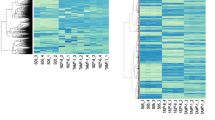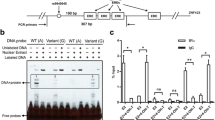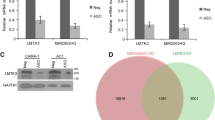Abstract
Purpose
In early stage, ERα-positive breast cancer, concurrent use of endocrine therapy and chemotherapy has not been shown to be superior to sequential use. We hypothesized that genetic biomarkers can aid in selecting patients who would benefit from chemo-endocrine therapy. Our previous studies revealed that ZNF423 is a transcription factor for BRCA1 and an intronic single nucleotide polymorphism (SNP) in ZNF423, rs9940645, determines tamoxifen response. Here, we identified mitosis-related genes that are regulated by ZNF423 which led us to investigate taxane response in a rs9940645 SNP- and tamoxifen-dependent fashion.
Methods
The Cancer Genome Atlas (TCGA) breast cancer dataset was used to identify genes correlated with ZNF423. Quantitative reverse transcription PCR, chromatin immunoprecipitation, and luciferase reporter assays were used to validate the gene regulation. We used CRISPR/Cas9 to engineer paired ZR-75-1 cells which differ only in ZNF423 rs9940645 SNP genotype to test SNP-dependent phenotypes including cell cycle and cell viability. We validated our findings in an additional two breast cancer cell lines, Hs578T-ERα and HCC1500.
Results
Mitosis-related genes VRK1 and PBK, which encode histone H3 kinases, were experimentally validated to be regulated by ZNF423. ZNF423 knockdown decreased VRK1 and PBK expression and activity. Additionally, ZNF423 knockdown enhanced docetaxel-induced G2/M arrest and cytotoxicity through VRK1 or PBK regulation. Lastly, cells carrying the rs9940645 variant genotype had increased G2/M arrest and decreased cell viability when treated with docetaxel in combination with estradiol and 4-OH-TAM.
Conclusions
We identified ZNF423 regulated genes involved in the G2/M phase of the cell cycle. 4-OH-TAM sensitized ERα-positive breast cancer cells to docetaxel in a ZNF423 SNP-dependent manner. Our findings suggest that patients with rs9940645 variant genotype may benefit from concurrent tamoxifen and docetaxel. This would impact a substantial proportion of patients because this SNP has a minor allele frequency of 0.47.







Similar content being viewed by others
Data availability
All experimental datasets generated are available in the supplementary materials submitted with this manuscript. Any additional information is available upon reasonable request to the corresponding author.
Abbreviations
- 4-OH-TAM:
-
4-Hydroxytamoxifene
- CALML3:
-
Calmodulin-like protein 3
- CRISPR:
-
Clustered, regularly interspaced short palindromic repeats
- DCT:
-
Docetaxel
- E2:
-
17β-Estradiol
- ER:
-
Estrogen receptor
- ERE:
-
Estrogen response element
- GO:
-
Gene ontology
- GWAS:
-
Genome-wide association study
- LCL:
-
Lymphoblastoid cell line
- NSABP:
-
National surgical adjuvant breast and bowel project
- OE:
-
Overexpress
- PARP:
-
Poly(ADP-ribose) polymerase
- PBK:
-
PDZ binding kinas
- qRT-PCR:
-
Quantitative reverse transcription polymerase chain reaction
- SERM:
-
Selective estrogen receptor modulator
- SNP:
-
Single nucleotide polymorphism
- TCGA:
-
The Cancer Genome Atlas
- WT:
-
Wild type
- VRK1:
-
Vaccinia-related kinase 1
- ZNF423:
-
Zinc finger protein 423
References
Siegel RL, Miller KD, Jemal A (2018) Cancer statistics, 2018. CA: a cancer journal for clinicians 68 (1):7–30. https://doi.org/10.3322/caac.21442
Ferlay J, Soerjomataram I, Dikshit R, Eser S, Mathers C, Rebelo M, Parkin DM, Forman D, Bray F (2015) Cancer incidence and mortality worldwide: sources, methods and major patterns in GLOBOCAN 2012. Int J Cancer 136(5):E359–E386. https://doi.org/10.1002/ijc.29210 doi
Albain KS, Barlow WE, Ravdin PM, Farrar WB, Burton GV, Ketchel SJ, Cobau CD, Levine EG, Ingle JN, Pritchard KI, Lichter AS, Schneider DJ, Abeloff MD, Henderson IC, Muss HB, Green SJ, Lew D, Livingston RB, Martino S, Osborne CK (2009) Adjuvant chemotherapy and timing of tamoxifen in postmenopausal patients with endocrine-responsive, node-positive breast cancer: a phase 3, open-label, randomised controlled trial. Lancet 374(9707):2055–2063. https://doi.org/10.1016/s0140-6736(09)61523-3
Bedognetti D, Sertoli MR, Pronzato P, Del Mastro L, Venturini M, Taveggia P, Zanardi E, Siffredi G, Pastorino S, Queirolo P, Gardin G, Wang E, Monzeglio C, Boccardo F, Bruzzi P (2011) Concurrent vs sequential adjuvant chemotherapy and hormone therapy in breast cancer: a multicenter randomized phase III trial. Journal of the National Cancer Institute 103(20):1529–1539. https://doi.org/10.1093/jnci/djr351
Sui M, Huang Y, Park BH, Davidson NE, Fan W (2007) Estrogen receptor alpha mediates breast cancer cell resistance to paclitaxel through inhibition of apoptotic cell death. Cancer Res 67(11):5337–5344. https://doi.org/10.1158/0008-5472.can-06-4582
Ingle JN, Liu M, Wickerham DL, Schaid DJ, Wang L, Mushiroda T, Kubo M, Costantino JP, Vogel VG, Paik S, Goetz MP, Ames MM, Jenkins GD, Batzler A, Carlson EE, Flockhart DA, Wolmark N, Nakamura Y, Weinshilboum RM (2013) Selective estrogen receptor modulators and pharmacogenomic variation in ZNF423 regulation of BRCA1 expression: individualized breast cancer prevention. Cancer Discov 3(7):812–825. https://doi.org/10.1158/2159-8290.CD-13-0038
Qin S, Ingle JN, Liu M, Yu J, Wickerham DL, Kubo M, Weinshilboum RM, Wang L (2017) Calmodulin-like protein 3 is an estrogen receptor alpha coregulator for gene expression and drug response in a SNP, estrogen, and SERM-dependent fashion. Breast Cancer Res 19(1):95. https://doi.org/10.1186/s13058-017-0890-x
Zerbino DR, Achuthan P, Akanni W, Amode MR, Barrell D, Bhai J, Billis K, Cummins C, Gall A, Girón CG, Gil L, Gordon L, Haggerty L, Haskell E, Hourlier T, Izuogu OG, Janacek SH, Juettemann T, To JK, Laird MR, Lavidas I, Liu Z, Loveland JE, Maurel T, McLaren W, Moore B, Mudge J, Murphy DN, Newman V, Nuhn M, Ogeh D, Ong CK, Parker A, Patricio M, Riat HS, Schuilenburg H, Sheppard D, Sparrow H, Taylor K, Thormann A, Vullo A, Walts B, Zadissa A, Frankish A, Hunt SE, Kostadima M, Langridge N, Martin FJ, Muffato M, Perry E, Ruffier M, Staines DM, Trevanion SJ, Aken BL, Cunningham F, Yates A, Flicek P (2018) Ensembl 2018. Nucl Acids Res 46(D1):D754–D761. https://doi.org/10.1093/nar/gkx1098
Liu D, Ho MF, Schaid DJ, Scherer SE, Kalari K, Liu M, Biernacka J, Yee V, Evans J, Carlson E, Goetz MP, Kubo M, Wickerham DL, Wang L, Ingle JN, Weinshilboum RM (2017) Breast cancer chemoprevention pharmacogenomics: deep sequencing and functional genomics of the ZNF423 and CTSO genes. NPJ Breast Cancer 3:30. https://doi.org/10.1038/s41523-017-0036-4
Niu N, Qin Y, Fridley BL, Hou J, Kalari KR, Zhu M, Wu TY, Jenkins GD, Batzler A, Wang L (2010) Radiation pharmacogenomics: a genome-wide association approach to identify radiation response biomarkers using human lymphoblastoid cell lines. Genome Res 20(11):1482–1492. https://doi.org/10.1101/gr.107672.110
Valbuena A, Sanz-García M, López-Sánchez I, Vega FM, Lazo PA (2011) Roles of VRK1 as a new player in the control of biological processes required for cell division. Cell Signal 23(8):1267–1272. https://doi.org/10.1016/j.cellsig.2011.04.002
del Puerto-Nevado L, Marin-Arango JP, Fernandez-Aceñero MJ, Arroyo-Manzano D, Martinez-Useros J, Borrero-Palacios A, Rodriguez-Remirez M, Cebrian A, Gomez del Pulgar T, Cruz-Ramos M, Carames C, Lopez-Botet B, Garcia-Foncillas J (2016) Predictive value of vrk 1 and 2 for rectal adenocarcinoma response to neoadjuvant chemoradiation therapy: a retrospective observational cohort study. BMC Cancer 16:519. https://doi.org/10.1186/s12885-016-2574-9
Huang W, Cui X, Chen Y, Shao M, Shao X, Shen Y, Liu Q, Wu M, Liu J, Ni W, Lu C, Wan C (2016) High VRK1 expression contributes to cell proliferation and survival in hepatocellular carcinoma. Pathol Res Pract 212(3):171–178. https://doi.org/10.1016/j.prp.2015.11.015
Lee N, Kwon JH, Kim YB, Kim SH, Park SJ, Xu W, Jung HY, Kim KT, Wang HJ, Choi KY (2015) Vaccinia-related kinase 1 promotes hepatocellular carcinoma by controlling the levels of cell cycle regulators associated with G1/S transition. Oncotarget 6(30):30130–30148. https://doi.org/10.18632/oncotarget.4967
Salzano M, Vazquez-Cedeira M, Sanz-Garcia M, Valbuena A, Blanco S, Fernandez IF, Lazo PA (2014) Vaccinia-related kinase 1 (VRK1) confers resistance to DNA-damaging agents in human breast cancer by affecting DNA damage response. Oncotarget 5(7):1770–1778. https://doi.org/10.18632/oncotarget.1678
Fournier MV, Martin KJ, Kenny PA, Xhaja K, Bosch I, Yaswen P, Bissell MJ (2006) Gene expression signature in organized and growth-arrested mammary acini predicts good outcome in breast cancer. Cancer Res 66(14):7095–7102. https://doi.org/10.1158/0008-5472.can-06-0515
Martin KJ, Patrick DR, Bissell MJ, Fournier MV (2008) Prognostic breast cancer signature identified from 3D culture model accurately predicts clinical outcome across independent datasets. PLoS One 3(8):e2994. https://doi.org/10.1371/journal.pone.0002994
Zykova TA, Zhu F, Wang L, Li H, Bai R, Lim DY, Yao K, Bode AM, Dong Z (2017) The T-LAK cell-originated protein kinase signal pathway promotes colorectal cancer metastasis. EBioMedicine 18:73–82. https://doi.org/10.1016/j.ebiom.2017.04.003
Ohashi T, Komatsu S, Ichikawa D, Miyamae M, Okajima W, Imamura T, Kiuchi J, Kosuga T, Konishi H, Shiozaki A, Fujiwara H, Okamoto K, Tsuda H, Otsuji E (2017) Overexpression of PBK/TOPK relates to tumour malignant potential and poor outcome of gastric carcinoma. Br J Cancer 116(2):218–226. https://doi.org/10.1038/bjc.2016.394
Ohashi T, Komatsu S, Ichikawa D, Miyamae M, Okajima W, Imamura T, Kiuchi J, Nishibeppu K, Kosuga T, Konishi H, Shiozaki A, Fujiwara H, Okamoto K, Tsuda H, Otsuji E (2016) Overexpression of PBK/TOPK contributes to tumor development and poor outcome of esophageal squamous cell carcinoma. Anticancer Res 36(12):6457–6466. https://doi.org/10.21873/anticanres.11244
Pirovano G, Ashton TM, Herbert KJ, Bryant RJ, Verrill CL, Cerundolo L, Buffa FM, Prevo R, Harrap I, Ryan AJ, Macaulay V, McKenna WG, Higgins GS (2017) TOPK modulates tumour-specific radiosensitivity and correlates with recurrence after prostate radiotherapy. Br J Cancer 117(4):503–512. https://doi.org/10.1038/bjc.2017.197
Kang TH, Park DY, Choi YH, Kim KJ, Yoon HS, Kim KT (2007) Mitotic histone H3 phosphorylation by vaccinia-related kinase 1 in mammalian cells. Mol Cell Biol 27(24):8533–8546. https://doi.org/10.1128/MCB.00018-07
Park JH, Lin ML, Nishidate T, Nakamura Y, Katagiri T (2006) PDZ-binding kinase/T-LAK cell-originated protein kinase, a putative cancer/testis antigen with an oncogenic activity in breast cancer. Cancer Res 66(18):9186–9195. https://doi.org/10.1158/0008-5472.CAN-06-1601
Nguyen PL, Taghian AG, Katz MS, Niemierko A, Abi Raad RF, Boon WL, Bellon JR, Wong JS, Smith BL, Harris JR (2008) Breast cancer subtype approximated by estrogen receptor, progesterone receptor, and HER-2 is associated with local and distant recurrence after breast-conserving therapy. J Clin Oncol 26(14):2373–2378. https://doi.org/10.1200/JCO.2007.14.4287
Gyorffy B, Hatzis C, Sanft T, Hofstatter E, Aktas B, Pusztai L (2015) Multigene prognostic tests in breast cancer: past, present, future. Breast Cancer Res 17:11. https://doi.org/10.1186/s13058-015-0514-2
Ades F, Zardavas D, Bozovic-Spasojevic I, Pugliano L, Fumagalli D, de Azambuja E, Viale G, Sotiriou C, Piccart M (2014) Luminal B breast cancer: molecular characterization, clinical management, and future perspectives. J Clin Oncol 32(25):2794–2803. https://doi.org/10.1200/JCO.2013.54.1870
Casoni F, Croci L, Bosone C, D’Ambrosio R, Badaloni A, Gaudesi D, Barili V, Sarna JR, Tessarollo L, Cremona O, Hawkes R, Warming S, Consalez GG (2017) Zfp423/ZNF423 regulates cell cycle progression, the mode of cell division and the DNA-damage response in Purkinje neuron progenitors. Development 144(20):3686–3697. https://doi.org/10.1242/dev.155077
Scharer CD, Laycock N, Osunkoya AO, Logani S, McDonald JF, Benigno BB, Moreno CS (2008) Aurora kinase inhibitors synergize with paclitaxel to induce apoptosis in ovarian cancer cells. J Transl Med 6:79. https://doi.org/10.1186/1479-5876-6-79
Payton M, Bush TL, Chung G, Ziegler B, Eden P, McElroy P, Ross S, Cee VJ, Deak HL, Hodous BL, Nguyen HN, Olivieri PR, Romero K, Schenkel LB, Bak A, Stanton M, Dussault I, Patel VF, Geuns-Meyer S, Radinsky R, Kendall RL (2010) Preclinical evaluation of AMG 900, a novel potent and highly selective pan-aurora kinase inhibitor with activity in taxane-resistant tumor cell lines. Cancer Res 70(23):9846–9854. https://doi.org/10.1158/0008-5472.CAN-10-3001
Ingle JN (1984) Integration of hormonal agents and chemotherapy for the treatment of women with advanced breast cancer. Mayo Clin Proc 59(4):232–238
Ingle JN, Everson LK, Wieand HS, Martin JK, Votava HJ, Wold LE, Krook JE, Cullinan SA, Paulsen JK, Twito DI et al (1988) Randomized trial of observation versus adjuvant therapy with cyclophosphamide, fluorouracil, prednisone with or without tamoxifen following mastectomy in postmenopausal women with node-positive breast cancer. J Clin Oncol 6(9):1388–1396. https://doi.org/10.1200/jco.1988.6.9.1388
Ingle JN, Everson LK, Wieand HS, Cullinan SA, Wold LE, Hagen JB, Martin JK, Krook JE, Fitzgibbons RG, Foley JF et al (1989) Randomized trial to evaluate the addition of tamoxifen to cyclophosphamide, 5-fluorouracil, prednisone adjuvant therapy in premenopausal women with node-positive breast cancer. Cancer 63(7):1257–1264
Acknowledgements
We would like to acknowledge Thomas Spelsberg, Ph.D. for providing the Hs578T-ERα cell line.
Funding
This work was supported by The Breast Cancer Research Foundation (BCRF-18-076) and Eisenberg Foundation. GW was supported by ChuYing Charity Foundation. JZ was supported by the Mayo Clinic Medical Scientist Training Program (T32 GM065841) and Initiative for Maximizing Student Development (R25 GM055252).
Author information
Authors and Affiliations
Contributions
GW, SQ, and JZ participated in data acquisition, data analysis, and manuscript writing. GW designed the study and drafted the manuscript. SQ generated the ZR75-1 CRISPR Cas9 genome edited cell line. ML carried out the ZNF423 and 4-OH-TAM screens. JNI provided invaluable clinical expertise and assisted in manuscript preparation. RMW conceived the study, participated in the study design, and provided guidance in data interpretation. KS provided clinical advice and helped apply for the ChuYing Charity Foundation support. LW conceived the study, participated in the study design, coordinated the study, and is responsible for all data as described. All authors approved the final manuscript.
Corresponding authors
Ethics declarations
Conflict of interest
ML is currently affiliated with AbbVie and, however, was not at the time of involvement in this study. LW and RMW are co-founders and stockholders in OneOme, LLC, a pharmacogenomic decision support company.
Ethical approval
All experiments performed in this publication comply with US laws. There were no human participants or animals used in this study.
Additional information
Publisher’s Note
Springer Nature remains neutral with regard to jurisdictional claims in published maps and institutional affiliations.
Electronic supplementary material
Below is the link to the electronic supplementary material.
10549_2019_5194_MOESM1_ESM.xlsx
Supplementary material 1. Online Resource 1: Table S1 Primers sequences for luciferase and ChIP assay are provided 5’ to 3’. Catalog numbers for predesigned qRT-PCR primers are also listed. (XLSX 9 KB)
10549_2019_5194_MOESM2_ESM.xlsx
Supplementary material 2. Online Resource 2: Table S2 Hs578T-ERα cells were transiently transfected with siRNA targeting each of the 368 candidate genes and an siRNA control (siControl). Gene expression was measured by by real-time quantitative reverse transcription-PCR (qRT-PCR) and normalized to housekeeping genes. There were 109 genes with at least a twofold change in gene expression upon ZNF423 knockdown; 99 downregulated and 10 upregulated genes. (XLSX 12 KB)
10549_2019_5194_MOESM3_ESM.xlsx
Supplementary material 3. Online Resource 3: Table S3 Lymphoblastoid cell lines (LCLs) overexpressing ERα with known rs9940645 genotypes were treated with vehicle control, E2, or E2 plus 4-OH-TAM. We used at least 7 different LCLs per genotype for each treatment. Gene expression of the 368 genes was measured by quantitative reverse transcription-PCR (qRT-PCR). There were 119 genes that displayed SNP-dependent expression pattern changes in the E2 plus 4-OH-TAM treatment compared to E2 alone. Eighty-two of the 119 genes had decreased expression in wild-type cells treated with 4-OH-TAM and increased expression in variant cells treated with 4-OH-TAM, which is the same direction of change that we observed previously with ZNF423 and BRCA1. (XLSX 20 KB)
10549_2019_5194_MOESM4_ESM.pptx
Supplementary material 4. Online Resource 4: Figure S1 GO Analysis was performed by inputting genes identified from the ZNF423 knockdown or 4-OH-TAM screen into the Cluego plugin of the Cytoscape software. Depicted is the GO analysis for the 4-OH-TAM screen. (A) GO terms are visualized as nodes and grouped into a network based on function (kappa score level ≥ 0.4). The size of each node represents the enrichment significance. (B-C) Each functional group (GO group) is labeled with a unique color and named using the most significant GO term within the group. Some GO terms were shared by different GO groups. (B) The pie chart illustrates the proportion by which each GO group was represented among the GO terms. Mitotic nuclear division was the most abundant GO group. (C) The significance of GO groups is shown ranked by Bonferroni-corrected p value. (PPTX 981 KB)
10549_2019_5194_MOESM5_ESM.xlsx
Supplementary material 5. Online Resource 5: Table S4 Results from gene ontology analysis of the 109 genes which had at least a twofold change in gene expression upon ZNF423 knockdown. (XLSX 20 KB)
10549_2019_5194_MOESM6_ESM.xls
Supplementary material 6. Online Resource 6: Table S5 Results from gene ontology analysis of the 119 genes that displayed SNP-dependent expression pattern changes in the E2 plus 4-OH-TAM treatment compared to E2 alone. (XLS 64 KB)
10549_2019_5194_MOESM7_ESM.xls
Supplementary material 7. Online Resource 7: Table S6 Comparison of genes within the most significant GO term from each screen. There were 7 overlapping genes from top GO terms, including VRK1 and PBK. (XLS 28 KB)
10549_2019_5194_MOESM8_ESM.pptx
Supplementary material 8. Online Resource 8: Figure S2 ZR-75-1 cells with WT or variant SNP genotype were transiently (A) knocked down with the indicated siRNA or (B) overexpressed with the indicated plasmids. Then, qRT-PCR was performed to determine the gene expression of ZNF423, VRK1, and PBK relative to control. Data shown as mean ± SEM. *p < 0.05, **p < 0.01, ***p < 0.001. (PPTX 359 KB)
Rights and permissions
About this article
Cite this article
Wang, G., Qin, S., Zayas, J. et al. 4-Hydroxytamoxifen enhances sensitivity of estrogen receptor α-positive breast cancer to docetaxel in an estrogen and ZNF423 SNP-dependent fashion. Breast Cancer Res Treat 175, 567–578 (2019). https://doi.org/10.1007/s10549-019-05194-z
Received:
Accepted:
Published:
Issue Date:
DOI: https://doi.org/10.1007/s10549-019-05194-z




